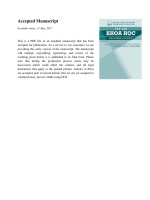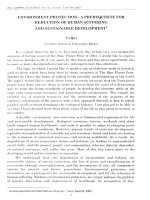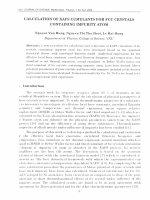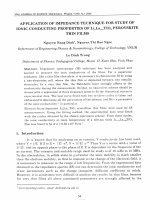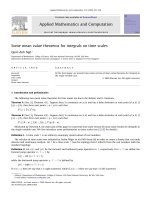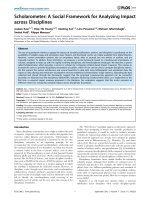DSpace at VNU: Ab initio chemical kinetics for the HCCO plus OH reaction
Bạn đang xem bản rút gọn của tài liệu. Xem và tải ngay bản đầy đủ của tài liệu tại đây (720.68 KB, 22 trang )
Accepted Manuscript
Ab Initio Chemical Kinetics for the HCCO + OH Reaction
Tam V-T Mai, P. Raghunath, Xuan T. Le, Lam K. Huynh, Pham-Cam Nam,
M.C. Lin
PII:
DOI:
Reference:
S0009-2614(13)01476-0
/>CPLETT 31787
To appear in:
Chemical Physics Letters
Received Date:
Accepted Date:
4 October 2013
29 November 2013
Please cite this article as: T.V-T. Mai, P. Raghunath, X.T. Le, L.K. Huynh, P-C. Nam, M.C. Lin, Ab Initio Chemical
Kinetics for the HCCO + OH Reaction, Chemical Physics Letters (2013), doi: />2013.11.060
This is a PDF file of an unedited manuscript that has been accepted for publication. As a service to our customers
we are providing this early version of the manuscript. The manuscript will undergo copyediting, typesetting, and
review of the resulting proof before it is published in its final form. Please note that during the production process
errors may be discovered which could affect the content, and all legal disclaimers that apply to the journal pertain.
Ab Initio Chemical Kinetics for the HCCO + OH Reaction
Tam V-T Mai1, P. Raghunath2, Xuan T. Le1, Lam K. Huynh*1, Pham-Cam Nam#3 and
M. C. Lin*2,4
1. Institute for Computational Science and Technology and International University, Vietnam National
University, Ho Chi Minh City, Vietnam
2. Center for Interdisciplinary Molecular Science, Department of Applied Chemistry, Hsinchu,
Taiwan.
3. Danang University of Technology, Danang, Vietnam.
4. Department of Chemistry, Emory University, Atlanta, GA, USA
# Emerson Visiting Fellow, Dec. 2009-Apr. 2010.
*Corresponding authors: email addresses: L.K. Huynh, ; M.C. Lin,
1
ABSTRACT
The mechanism for the reaction of HCCO and OH has been investigated at different highlevels of theory. The reaction was found to occur on singlet and triplet potential energy surfaces with
multiple accessible paths. Rate constants predicted by variational RRKM/ME calculations show that
the reaction on both surfaces occurs primarily by barrierless OH attack at both C atoms producing
excited intermediates which fragment to produce predominantly CO and
1,3
HCOH with kS=3.12x10-8
T-0.59 exp[-73.0/T] and kT = 6.29x10-11 T0.13 exp[108/T] cm3molecule−1s−1 at T = 300-2000 K,
independent of pressure at P < 76000 Torr.
Keywords: ketenyl, hydroxyl, hydroxyketene, rate constant, product branching ratio, RRKM and
master equation.
2
1. Introduction
The ketenyl (HCCO) radical has been considered as a key intermediate in the oxidation of
hydrocarbon fuels, especially in the case of acetylene, an important core hydrocarbon and also a major
intermediate in almost all hydrocarbon-fueled flames. Ketenyl is mainly formed by the C2H2+O
reaction [1-5] whose two important product channels are:
C2H2 + O(3P)
→ HCCO + H
(Rxn. 1)
→ CH2 + CO
(Rxn. 2)
where HCCO is found to be the principal product accounting for more than 60% of product yield in a
wide range of temperature and pressure. Therefore, subsequent ketenyl consumption has attracted
much attention. Specifically, there are a number of experimental as well as theoretical studies on the
reactions of HCCO with other species such as H [2,6], O [7-9], O2 [10-14], H2 [15], C2H2 [11,14,16],
NO [14,17-21], NO2 [14,15,22-24] and SO2 [25].
Of the most reactive species, especially in the combustion of hydrocarbons, OH radical plays
the most important role in the ketenyl oxidation chemistry. However, not much reliable and
comprehensive kinetic information, both theoretically and experimentally, is available for the reaction
of HCCO and OH, except estimated rate constants for direct hydrogen abstraction which have been
included inconsistently in available kinetic models (e.g., OH + HCCO → C2O + H2O [26], OH +
HCCO → H2CCO + O [26,27], OH + HCCO → HCCOH + O [27]), in order to fit simulation species
profiles to experimental data under different conditions. This is our motivation to accurately
characterize the kinetic behaviors of the reaction.
The HCCO + OH reaction can proceed by either addition of the OH to the C=C Π-bond of
HCCO at two different C-sites to form energized adducts, followed by their unimolecular reactions, or
by direct mutual hydrogen abstraction reactions. These reactions can occur on both singlet and triplet
surfaces consisting of multiple wells (intermediates) via multiple paths. Therefore, in this work, the
potential energy surfaces (PES’s) of the HCCO + OH reaction have been explored using highly
accurate levels of theory, such as CBS-QB3, CBS-APNO and W1U. On such well-characterized
PES’s, rate constant calculations for all accessible channels are then carried out to identify the
formation of major products as well as their branching ratios under different conditions of
temperatures and pressures of relevance to combustion. Thermodynamic data for all related species
are also derived so that the detailed kinetics for the HCCO+OH sub-mechanism can be used as a core
sub-model for construction of detailed oxidation mechanisms of real fuels.
3
2. Computational methods
Electronic Structure Calculations. All calculations were carried out using the
Gaussian09 [28] program. The composite CBS-QB3 method by Peterson and coworkers
[29] was employed as an effective compromising method in terms of accuracy and
computational time. The highly-accurate methods, namely CBS-APNO [30] and W1U
[31], were also utilized as a reference point for the CBS-QB3 calculations. All reported
results for stable molecules as well as transition states were obtained for the lowest-lying
conformer of a given species.
For barrierless reactions occurring without intrinsic transition states, conventional singlereference methods might fail to accurately capture the potential surface when the fragments are farther
away. For this reason, the multi-reference CASPT2 method [32] was used to characterize such
channels. All of these calculations were carried out using the Molpro2010 [33] program.
Rate constant calculations. Temperature- and pressure-dependent rate constants for key lowlying reaction channels on the PES’s have been calculated using Rice-Ramsperger-Kassel-Marcusbased Master Equation (RRKM/ME) methodology
implemented in the Variflex code [34]. For
barrierless channels, we did variationally the optimized bond length to separated radical pairs with an
interval of 0.1 Å by second-order multireference perturbation theory CASPT2(12e,9o)//CAS(12e,9o)
method with cc-pVTZ and 6-311+G(3df,p) basis sets. The discrete CASPT2 values were fitted to a
Morse potential by which the rate constants were derived. Lennard-Jones (LJ) parameters, σ =
3.47 Å and ε/kB = 114 K for Ar bath gas was taken from the literature [35] while the values σ = 4.41
and ε/kB = 470 K were estimated based on similar species (e.g., C2H5O2 from LLNL mechanisms
[36]). The energy transfer per downward collision was approximated using the exponential down
model with ΔEdown
= 400 cm-1. Hindered internal rotation (HIR) and Eckart tunneling corrections
were included.
3. Results and discussion
3.1. Potential energy surface and reaction mechanism
In order to characterize the kinetics of the reaction between HCCO and OH, a
reliable and detailed PES is needed. To our best knowledge, such a PES is not available
for this system; thus we have attempted to construct it using high levels of theory. Figure
4
1 presents the PES at 0 K of the HCCO-OH system established by the composite CBSQB3 method. For clarity, high-energy reaction channels having barriers higher than 65
kcal/mol above the entrance level, such as CHCOOH (IM9) → products, are not
included. In addition, values obtained by other highly accurate methods (W1U and CBSAPNO), are given in Supplementary Table S2. Optimized geometries of all species with
important geometrical parameters at
the
CBS-QB3 level are provided in Supplementary
Figure S1. Detailed molecular information of the involved species can be found in
Supplementary Table S4.
To
facilitate the discussion, the CBS-QB3 values are used
universally and the energies are cited relative to that of the reactants; otherwise it will be
explicitly stated.
3.1.1. Singlet sub-surface
Figure 1 presents the singlet sub-surface of the HCCO and OH reaction forming internallyenergized adducts by C-O bond formation. The hydroxyl radical can add to one of the two C atoms of
HCCO to form either hydroxyl ketene, HOCH=C=O (IM1), or carboxyl methylidene, HC=C(=O)OH
(IM4), occurring barrierlessly with high exothermicity ( ΔH rxn (0 K) = -87.1 and -44.0 kcal/mol,
respectively). The energized adducts can undergo reactions by isomerization and dissociation, and by
collisional deactivation. These competing processes will change product branching ratios with
temperature and pressure.
From the more stable adduct IM1, 9 possible reaction pathways can occur as described
below:
(1)
HCCO + OH (R) redissociation. The adduct IM1 can redissociate back to the
reactants along the minimum energy path (MEP) characterized by variable reaction
coordinate transition state theory (VRC-TST).
(2)
H2CO + CO (P2) formation. This is the second most thermodynamically favorable
channel whose products are formed via the 1,2-H-shift across the C-O bond,
accompanied by the C=C bond breaking. This channel has the barrier energy of
60.3 kcal/mol, lying at -26.8 kcal/mol; thus this channel is expected to be important,
especially at low temperatures.
(3)
CO + 1HCOH (P3) formation. The C=C bond at IM1 can be directly broken to form
CO and singlet-state hydroxymethylene 1HCOH with the barrier close to reaction
5
energy (44 and 52.3 kcal/mol, respectively), suggesting that the TS has the productlike structure (cf. Figure S1).
(4)
H + OCHCO (P6) formation. The breaking of the O-H bond to give H + OCHCO
(P6) is a barrierless reaction with a high barrier of 70.7 kcal/mol but still lying
below the entrance channel (-16.4 kcal/mol).
(5)
H + HOCCO (P9) formation. Similar to the previous channel, IM1 can dissociate to
H + HOCCO by breaking the C-H bond. Due to missing resonance structure as
observed in P6 (O*-CH=C=O ↔ O=CH-C*=O forms), this channel has a higher
barrier (92.3 vs. 70.7 kcal/mol).
(6)
H2O + 1CCO (P8) formation. These bimolecular products can be formed via the van
der Waals complex (C1) whose barrier (from IM1) and energy is 9.3 and 17.8
kcal/mol below the entrance channel, respectively. It is expected that a roaming TS
can exist between the reactants and these products; however, because the energy of
H2O + 1CCO is comparable with the reactant energy (0.1 kcal/mol above the
reactants), the formation via such a TS is expected to play a less important role
comparing to the other low-energy lying channels.
(7)
trans-glyoxal (IM2) isomerization and subsequent reactions. Hydrogen of the OH
group can undergo a 1,3-H migration to form trans-glyoxal (IM2) with a barrier
height of 55.8 kcal/mol and reaction energy of -15.4 kcal/mol. Intermediate IM2
then can either dissociate to form CO + H2CO (P2), CO + 1HCOH (P3), CHO +
CHO (P5) or isomerize to cis-glyoxal (IM3) which can subsequently dissociate to
2CO + H2 (P1), the most thermodynamically favorable products (-107.7 kcal/mol).
(8)
1
CH=C(=O)OH (IM4) isomerization. Singlet-state carboxyl methylidene can be
formed through the OH migration from IM1 to the C atom of the carbonyl group
with a barrier energy of 49.2 kcal/mol. Alternatively, the adduct can be formed
directly from the addition of OH to carbonyl carbon of HCCO. The IM1-IM4
connection makes the potential more complicated especially in kinetic analysis.
(9)
HC≡COOH (IM9) isomerization. The rearrangement to the peroxy compound HC
≡C-OOH is very tight with a high reaction barrier of 92.3 kcal/mol. The
subsequent decomposition reaction of IM9 occurs even with a much higher barrier
6
(e.g., 65 kcal/mol above the entrance channel); thus it is not included in the
analysis.
In the same manner, the initially-formed adduct IM4 can undergo isomerization to form IM1
and oxiran-2-one (IM5) or redissociate back to the reactants, HCCO + OH. Oxiran-2-one then can
decompose by simultaneously breaking the C-O and C-C bonds of the oxirane ring to give CO2 +
1
CH2 products (P4). These channels have relative energies much below the reactant energy (-41.7 and
-36.7 kcal/mol for IM4→IM5 and IM5→P4, respectively); thus they can strongly compete with other
channels at low temperature and high pressure.
3.1.2. Triplet sub-surface
Similarly, on this sub-surface hydroxyl radical can attach to both C atoms of HCCO via complex
C2 to form triplet-state adducts IM6 and IM7 with much shallower well-depths. These adducts can
isomerize and/or decompose to form bimolecular products. Alternatively, direct hydrogen abstraction
channels also exist on this triplet sub-surface to form H2O + CCO (P12), H2CCO + 3O (P13) and
HCCOH + 3O (P14). These channels are described as follows
(1)
3
CH2 + CO2 (P10) formation. This is the most stable product channel on this
subsurface with the relative energy of -52.4 kcal/mol. Initially, the reactant
combination results in a van der Waals complex HO⋅⋅⋅CHCO (C2) which then can
transform to 3CHC(OH)=O (IM7) through a very loose and low-energy TS with the
barrier of 0.3 kcal/mol. The adduct IM7 can isomerizes through a four-member-ring
H-migration TS to form 3CH2CO2 (IM8) before dissociating to the final products,
(2)
3
CH2 + CO2, by breaking the C-C bond.
3
HCOH + CO (P11) formation. The adduct 3HOCHCO (IM6) can be formed by
OH addition to the H-containing C atom. This process is barrierless with the
reaction energy of -56.3 kcal/mol. From this adduct 3HCOH + CO (P11) can be
formed with a relative energy of -26.4 kcal/mol, having a product-like TS (the
reaction barrier and energy are 33.2 and 29.9 kcal/mol, respectively).
(3)
3
CCO + H2O (P12) formation (H-abstraction by OH). The OH radical can directly
abstract H atom of HCCO to form 3CCO+H2O with the barrier of 4.1 kcal/mol.
(4)
H2CCO + 3O (P13) formation (H-abstraction by HCCO). The H abstraction from
OH by the H-containing C atom of HCCO goes through the formation of the
complex C2 before forming H2CCO + 3O products (P13). The calculated barrier
7
height for this process is 12.5 kcal/mol at the CBS-QB3 level; the products form a
post-reaction van der Waals complex, O⋅⋅⋅CH2CO (C3), which can easily
decompose to the product (at -3.1 kcal/mol) with no TS.
(5)
HC≡COH + 3O (P14) formation (H-abstraction by HCCO). The O atom of HCCO
radical can abstract the H-atom of OH to give HCCOH + 3O (P14) products. This
reaction occurs through a tight TS, followed by a van der Waals complex C4 which
is 17.9 kcal/mol below the products. The TS has a relatively high energy of 32.6
kcal/mol via a van der Waals complex C4; this channel is expected to be less
favorable than others.
The calculated PES at the CBS-QB3 level agrees very well with the one obtained with the
more accurate W1U method, typically within 1 kcal/mol for reaction barriers and reaction energies
(c.f. Supplementary Table S2 for details). In this context, the CBS-QB3 values are even better than the
CBS-ANPO values. Such an excellent agreement provides us with confidence in using the CSB-QB3
energies for thermodynamic calculations and kinetic analysis.
3.2. Thermodynamic properties calculations
Table 1 presents the calculated reaction enthalpies at different levels of theory in this study,
namely CBS-QB3, W1U and CBS-APNO. The CBS-QB3 values are found to be closer to the most
accurate W1U results than the CBS-APNO ones. The CBS-QB3 values predicted at 298 K are also
provided for comparison with available experimental/ab initio data. Good agreement was achieved
typically within 1 kcal/mol.
The reaction barriers for selected reactions at different levels are shown in Table 2. It is worth
mentioning that the CBS-QB3 numbers are almost identical to those from W1U which is an expensive
method. Thus CBS-QB3 is the method of choice for both accuracy and computational time.
Ketenyl (HCCO) radical. The HCCO radical has been a subject of several experimental
and theoretical studies [42-49]. Some basic thermochemical parameters have also been
determined by experiments including the heat of formation (∆Hf) [47], electron affinity
(EA) [44,45] and bond dissociation energy (BDE) [44]. Table 3 presents the calculated
values in comparison with available data in the literature. Evidently our CBS-QB3 values
agree better with the available experimental data.
8
3.3. Rate constant calculations
Rate constants for all reaction channels on the well-defined PES described in
Figure 1 have been predicted by RRKM/ME calculations. The high-pressure limit rate
constant for barrierless reactions are computed by using the VRC-TST approach with the
CASPT2 potential.
Reactions on the singlet surface. As aforementioned, there are two initial association
paths for HCCO + OH, taking place by OH addition to the two different C atoms
producing HC(OH)=CO (IM1) and HCC(OH)=O (IM4) with 87.1 and 44.0 kcal/mol of
internal excitation, respectively. IM4 can isomerize to IM1 by OH-migration via a small
(6.1 kcal/mol) barrier at TS4 because of the instability of the former, carboxyl
methylidine. The computed potential energies for IM1 and IM4 decomposition to HCCO
+ OH along their barrierless MEP’s could be fitted to the Morse function with β = 2.41 Å1
and β = 2.02 Å-1 respectively; these values were used for C-O bond breaking rate
constant calculations. The high pressure-limit rate constants for the initial association
processes predicted for two temperature ranges based on the computed VTS curves by
CASPT2 can be represented by the following equations in units of cm3 molecule-1 s-1:
k R∞→ IM1 = 2.54 x 10-10 exp[-57.1/T]
(300-1000 K)
(Eq. 2a)
(300-2000 K)
(Eq. 2b)
(300-1000 K)
(Eq. 3a)
= 8.40 x 10-11 T0.14 exp[34.5/T] (300-2000 K)
(Eq. 3b)
= 6.16 x 10-11 T0.19 exp[42.4/T]
kR∞→ IM4 = 2.45 x 10-10 exp[-40.7/T]
Both rate constants appear to be very similar in magnitude (as can be more clearly seen from their
Arrhenius expressions derived for the low-T range, Eqs. 2a and 3a), reflecting the close similarity in
the two variational association processes. We have done the rate constant calculations using the W1U
energies for the forward reactions of HCCO + OH via singlet and triplet surface producing various
low energy products with multiple reflection corrections and compared with those by CBS-QB3 are
shown in Supplementary Figures S3 and S4. All the calculations at the W1U level of theory are in
9
good agreement with those by the CBS-QB3 method. Under practical T,P-conditions, the internallyexcited adducts can readily undergo isomerization and fragmentation producing various products;
these reactions are competitive with the collisional quenching process which gives rise to the pressure
dependence. The specific rate constants for the isomerization and decomposition of the two excited
intermediates, HC(OH)=CO* and HCC(OH)=O*, are shown in Figure 2 to illustrate their relative
importance. At 49.8 kcal/mol excess energy above the lowest barrier responsible for the production of
CO + HCOH (P3), only 3 reactions are seen to be competitive and all others are many orders of
magnitude smaller and cannot compete significantly. They are the isomerization of IM4 to IM1 by
OH migration and IM4 to IM5 (oxyiran-2-one) by concerted H-migration and ring formation, and the
decarbonylation of IM1 producing the P3 product pair. The first two reactions involving IM4* was
shown to be dominated by the IM4 to IM1 conversion as illustrated by a separate Variflex calculation
for thermally averaged rate constants by taking into account the structural effects of their transition
states. The result indicated that the rate constant for the IM4 to IM1 conversion is much greater than
that for the isomerization producing IM5. Based on this result we can conclude that for the first
approximation, the reaction of HCCO + OH via both intermediates produces the CO + HCOH as their
primary dominant products. We can therefore predict the rate constant for the reaction on the singlet
surface by considering the following processes:
OH + HCCO → IM1* → CO + HCOH
(Rxn. 3)
→ IM4 → IM1 → CO + HCOH
(Rxn. 4)
Figure 3 illustrates the individual contributions of the two paths and their total value, which
can be represented by
kP3 = 3.12 x 10-8 T-0.59exp[-73.0/T] cm3 molecule-1 s-1 (300-2000 K)
(Eq. 4)
At 1000 K, the IM1 path given by Rxn. 3 contributes 6 times as much P3 as that from the IM4 path in
Rxn. 4.
Reactions on the triplet surface.
As mentioned in the preceding section, the
bimolecular reaction of HCOO + OH occurring on the triplet surface produces primarily
3
CH2 + CO2 (P10) and 3HCOH + CO (P11) as shown in Figure 1b. Variational TST and
RRKM calculations have been carried out for following paths with the Variflex code.
10
HCCO + OH → IM7* → 3CH2 + CO2 (P10)
(Rxn. 5)
HCCO + OH → IM6* → 3HCOH + CO (P11)
(Rxn. 6)
As shown in Figure 1b the first reaction occurs via the pre-reaction complex C2; the potential energy
curve forming C2 was calculated by lengthening the complexing C-H bond from 2.16 to 5.0 Å with an
interval of 0.1 Å. The computed potential energies can be reasonably fitted to the Morse function with
β = 1.33 Å-1. The rate constants have been predicted for the formation of the 3CH2 + CO2 products
with and without multiple reflections above the C2 complex. The results indicated that at 300 K (the
lowest temperature computed) and at both 760 Torr and the high pressure limit, the effect of multireflection corrections is negligible (see Supplementary Figure S2). In addition, the effect of pressure
on the 3CH2 + CO2 (P10) product formation is negligible at P < 7600 Torr as shown in Figure 4. The
predicted rate constant for this process covering the temperature range of 300–3000 K at P < 7600
Torr Ar pressure can be given by the following three parameter expression:
kP10 = 1.49 × 10-19 T2.09 exp[1105/T] cm3 molecule−1 s−1 (200–3000 K)
(Eq. 5)
The second association reaction of HCCO with OH producing 3HOCHCO (IM6) also occurs
without a well-defined transition state; the excited IM6 intermediate carries as much as 56.3 kcal/mol
of internal energy with 23.1 kcal/mol of excess energy above the transition state for CO elimination
via TS13; giving the 3HCOH and CO as shown in Figure 1(b). The computed potential energies of
IM6 → HCCO + OH formation by C-O bond breaking could be fitted to the Morse function with β =
3.76 Å-1. The predicted rate constants at P < 7600 Torr Ar pressure for 3HCOH + CO (P11) formation
can be represented in units of s-1 by:
kP11 = 6.29 × 10-11 T0.13 exp[10.8/T] cm3 molecule−1 s−1 (300-1000 K)
-9
4.36 × 10 T
-0.41
3
−1 −1
exp[-505.9/T] cm molecule s
(Eq. 6)
(1000-2000 K)
We have also computed the rate constant for the direct H-abstraction reaction, HCCO + OH →
H2O + 3CCO which has a 4.1 kcal/mol barrier. As expected, it is much smaller than the complex
forming processes discussed above particularly at low temperatures; however, as the temperature
increases, it becomes more competitive as shown in Figure 4. The rate constant can be given by the
three parameter expression covering the temperature range of 300–2000 K kCCO = 1.15×10-19 T2.40
exp(-1186.0/T) cm3mol−1s−1. As seen from Figure 4, on the triplet surface the HCCO+OH reaction
produces primarily 3HCOH + CO throughout the whole temperature range studied.
11
4. Concluding remarks
In this work we have carried out a comprehensive computational study on the mechanism for the
HCCO + OH reaction using several high-level computational methods including CBS-QB3, CBSAPNO and W1U. The detailed CBS-QB3 PES’s indicate that the reaction can occur on both singlet
and triplet surfaces by OH addition to the C=C Π–bond at both C atoms producing internally excited
HC(OH)C=O and HCC(OH)=O which can undergo many isomerization and decomposition reactions
yielding a variety of intermediates and products, CO + HCOH, CH2 + CO2, CO + CH2O, (HCO)2,
2CO + H2, and other products with high endothermicities. The energy barriers and thermodynamic
quantities (such as ΔH f , ΔH rxn , etc) for these reactions and the species involved have been
computed with the 3 methods and compared with available experimental data. In general, the
agreement was found to be excellent. Among the various accessible product channels, the CO +
1,3
HCOH products were found to be dominant over the entire temperature range (300-2000 K) studied
at P < 76,000 Torr Ar pressure. Under combustion conditions, the HCOH thus formed can rapidly
covert to CH2O (within a few μs at 1000 K).
To test the validity of the present ab initio chemical kinetic predictive approach by RRKM/ME
calculations, we have computed the rate constant for the (CHO)2 decomposition reaction, whose
kinetic
data
are
available
in
the
NIST
Chemical
Kinetics
Database
( The predicted heats of reaction of glyoxal (CHO)2 and rate
constants for dissociation to various products, 2CO + H2, CH2O + CO and CHO + CHO, are in good
agreement with experimental values as presented in the Supplementary Information.
Acknowledgement
The authors deeply appreciate the support by Taiwan’s National Science Council (NSC) under
contract No. NSC100-2113-M-009-013 and by the Ministry of Education’s ATU program. MCL also
acknowledges the support from the NSC for the distinguished visiting professorship at National Chiao
Tung University (NCTU) in Hsinchu, Taiwan. LKH would like to thank NSC for the short visit at
NCTU in summer 2013. We are also grateful to the National Center for High-performance Computing
and Institute for Computational Science and Technology for computer time and the use of its facilities.
Supplementary material
12
Supplementary data associated with this article can be found, in the online version, at
/>
References
[1]
[2]
[3]
[4]
[5]
[6]
[7]
[8]
[9]
[10]
[11]
[12]
[13]
[14]
[15]
[16]
[17]
[18]
[19]
[20]
[21]
[22]
[23]
[24]
[25]
[26]
[27]
[28]
[29]
[30]
[31]
[32]
[33]
[34]
[35]
A.M. Schmoltner, P.M. Chu, Y.T. Lee, J. Chem. Phys. 91 (1989) 5365.
W. Boullart, J. Peeters, J. Phys. Chem. 96 (1992) 9810.
G. Capozza, E. Segoloni, F. Leonori et al., J. Chem. Phys. 120 (2004) 4557.
T.L. Nguyen, L. Vereecken, J. Peeters, J. Phys. Chem. A 110 (2006) 6696.
S.A. Carl, L. Vereecken, J. Peeters, PCCP 9 (2007) 4071.
G.P. Glass, S.S. Kumaran, J.V. Michael, J. Phys. Chem. A 104 (2000) 8360.
J. Peeters, W. Boullart, K. Devriendt, J. Phys. Chem. 99 (1995) 3583.
J. Peeters, I. Langhans, W. Boullart et al., J. Phys. Chem. 98 (1994) 11988.
V. Chikan, S.R. Leone, J. Phys. Chem. A 109 (2005) 2525.
S.A. Carl, Q. Sun, J. Peeters, J. Chem. Phys. 114 (2001) 10332.
K.K. Murray, K.G. Unfried, G.P. Glass et al., Chem. Phys. Lett. 192 (1992) 512.
D.L. Osborn, J. Phys. Chem. A 107 (2003) 3728.
S.J. Klippenstein, J.A. Miller, L.B. Harding, Proc. Combust. Inst. 29 (2002) 1209.
F. Temps, H.G. Wagner, M. Wolf, Z. Phys. Chem. 176 (1992) 27.
S.A. Carl, Q. Sun, L. Teugels et al., PCCP 5 (2003) 5424.
H.B. Xie, Y.H. Ding, C.C. Sun, J. Phys. Chem. A 110 (2006) 7262.
S.A. Carl, Q. Sun, L. Vereecken et al., J. Phys. Chem. A 106 (2002) 12242.
J.P. Meyer, J.F. Hershberger, J. Phys. Chem. B 109 (2005) 8363.
K.T. Rim, J.F. Hershberger, J. Phys. Chem. A 104 (2000) 293.
I.V. Tokmakov, L.V. Moskaleva, D.V. Paschenko et al., J. Phys. Chem. A 107
(2003) 1066.
M.T. Nguyen, W. Boullart, J. Peeters, J. Phys. Chem. 98 (1994) 8030.
J.P. Meyer, J.F. Hershberger, J. Phys. Chem. A 109 (2005) 4772.
M.T. Hien, T.L. Nguyen, S.A. Carl et al., Chem. Phys. Lett. 416 (2005) 199.
J.X. Zhang, Z.S. Li, J.Y. Liu et al., J. Phys. Chem. A 110 (2006) 2527.
L. Du, S.A. Carl, The journal of physical chemistry. A 116 (2012) 10074.
J.A. Miller, C.F. Melius, Combust. Flame 91 (1992) 21.
P. Glarborg, M.U. Alzueta, K. Dam-Johansen et al., Combust. Flame 115 (1998)
1.
M.J. Frisch, G.W. Trucks, H.B. Schlegel et al., Gaussian 09, Revision A.1.
Gaussian, Inc., Wallingford CT, 2009.
J.A. Montgomery-Jr., M.J. Frisch, J.W. Ochterski et al., J. Chem. Phys. 110
(1999) 2822.
J.W. Ochterski, G.A. Petersson, J.A. Montgomery, J. Chem. Phys. 104 (1996)
2598.
J.M.L. Martin, G.n. de Oliveira, J. Chem. Phys. 111 (1999) 1843.
P. Celani, H.-J. Werner, J. Chem. Phys. 112 (2000) 5546.
H.-J. Werner, P. J. Knowles, G. Knizia et al., MOLPRO, a package of ab initio
programs, 2010.
S.J. Klippenstein, A.F. Wagner, R.C. Dunbar et al., Variflex, version 1.0,
Argonne National Laboratory, Argonne, IL, 1999.
H. Hippler, J. Chem. Phys. 78 (1983) 6709.
13
[36]
[37]
[38]
[39]
[40]
[41]
[42]
[43]
[44]
[45]
[46]
[47]
[48]
[49]
/>t_v1b.txt.
B. Ruscic, J.E. Boggs, A. Burcat et al., J. Phys. Chem. Ref. Data 34 (2005) 573.
P.G. Szalay, A. Tajti, J.F. Stanton, Mol. Phys. 103 (2005) 2159.
A. Burcat, B. Ruscic, Argonne National Laboratory Report (ANL-05/20), Sept.
2005
D.M. Koch, N.H. Khieu, G.H. Peslherbe, J. Phys. Chem. A 105 (2001) 3598.
P.R. Schreiner, H.P. Reisenauer, F.C.P. IV et al., Nature 453 (2008) 906.
D.H. Mordaunt, D.L. Osborn, H. Choi et al., J. Chem. Phys. 105 (1996) 6078.
D.L. Osborn, D.H. Mordaunt, H. Choi et al., J. Chem. Phys. 106 (1997) 10087.
J.M. Oakes, M.E. Jones, V.M. Bierbaum et al., J. Phys. Chem. 87 (1983) 4810.
B. Schäfer-Bung, B. Engels, T.R. Taylor et al., J. Chem. Phys. 115 (2001) 1777.
Y. Ohshima, Y. Endo, J. Mol. Spectrosc. 159 (1993) 458.
L.R. Brock, B. Mischler, E.A. Rohlfing et al., J. Chem. Phys. 107 (1997) 665.
K.G. Unfrieda, R.F. Curla, J. Mol. Spectrosc. 150 (1991) 86.
K.W. Sattelmeyer, Y. Yamaguchi, H.F. Schaefer, Chem. Phys. Lett. 383 (2004)
266.
14
Figure 1. The simplified potential energy surface (0 K) computed at the CBS-QB3 level
for possible channels of the HCCO+OH reaction: (a) Singlet and (b) Triplet surfaces.
High-energy channels are not included for clarity. Values are in kcal/mol.
15
14
IM1
(via IM4)
49.8 kcal/mol
12
log k(E) / s
-1
P6
IM5
10
(via IM4)
P3
8
6
4
P8
IM2
IM5
2
0
CO + HCOH (P3)
H + OCHCO (P6)
H2O + CCO (P8)
IM2 (glyoxal)
IM5 (oxiran-2-one)
IM5
(via IM4; CH=C(O)OH)
IM1 (HOCH=C=O)
(via IM4)
Figure 2. Rate coefficients
as a function
of energy
0
50
100 for the singlet
150 decomposition
200 channels of
HOCH=C=O (IM1) and CH=C(O)OH (IM4).
E /kcal/mol
16
Figure 3. Arrhenius plots of rate constants for production of CO+HCOH via IM1 and
IM4 in the HCCO+OH reaction.
Figure 4. Arrhenius plots of rate constants for HCCO+OH reaction forming various
products at triplet surface state at different independent pressures range 0.0001-7600
Torr.
17
Table 1. The calculated reaction enthalpies (0 K, in kcal/mol) at the CBS-QB3 level
comparing with available experimental values. Numbers in parentheses are 298 K results.
Reactions
HCCO + OH → HOCH=C=O (IM1)
HCCO + OH → 2CO + H2 (P1)
CBS-QB3
-87.1
(-88.6)
This work
W1U
CBS-APNO
-86.7
-85.5
-
Literaturea
(-88.6±0.4)
HCCO + OH → CHO + CHO (P5)
-107.7
(-106.4)
-105.2
(-105.7)
-52.3
(-52.7)
-44.5
(-44.8)
-32.0
(-32.1)
-105.9
-104.2
-52.0
-43.3
-31.8
-
-105.3
-103.2
-50.6
-42.2
-31.4
-
(-104.4±0.5)
(-103.9±0.4)
(-43.1±0.4)
(-31.3±0.4)
HCCO + OH→ H + OCHCO (P6)
-16.4
(-16.6)
-14.5
-
-15.0
-
-
HCCO + OH → CO + H2CO (P2)
HCCO + OH → CO + 1HCOH (P3)
HCCO + OH → CO2 + 1CH2 (P4)
HCCO + OH → 1C2O + H2O (P8)
0.1
0.4
2.1
(0.0)
5.2
6.0
5.8
HCCO + OH → H + HOCCO (P9)
(5.0)
-52.4
-52.4
-51.2
HCCO + OH → CO2 + 3CH2 (P10)
(-52.6)
(-52.1±0.4)
-26.4
-26.8
-25.6
HCCO + OH → CO + 3HCOH (P11)
(-26.6)
-18.9
-18.4
-17.2
HCCO + OH → 3C2O + H2O (P12)
(-18.3)
(-18.8±0.4)
-3.1
-3.3
-2.7
HCCO + OH → CH2CO + 3O (P13)
(-3.8)
(-3.2±0.4)
30.6
30.1
31.8
HCCO + OH → HCCOH + 3O (P14)
(30.2)
(29.7±0.4)
a
The data (in kcal.mol-1) are derived from literature at 298.15 K: 3O, 58.98±0.02 [37]; OH, 8.92±0.07
[37]; H2O, -57.80±0.01 [37]; CO,-26.42 [38]; CHO, 10.11±0.07 [37]; H2CO, -25.95 [37]; HCCO,
42.61±0.36 [38]; 3C2O, 90.55 [39]; CH2CO, -10.64 [37]; HOCH=C=O, -37.08 [39]; 1CH2,
102.49±0.38 [37]; 3CH2, 93.50±0.38 [37]; CO2, -94.04 [39]; HCCOH, 22.27 [39].
Table 2. Comparison of the calculated reaction barriers (at 0 K, in kcal/mol) with the
available literature data. Numbers in parentheses are 298 K values.
18
Reaction barrier, V≠
Reaction
1
trans-glyoxal→CO + HCOH
trans-glyoxal→CO + H2CO
cis-glyoxal→2CO + H2
trans-HCOH→H2CO
trans-HCOH→cis-HCOH
cis-HCOH→CO + H2
a
CBS-QB3a
60.8
(60.9)
55.7
(55.6)
55.6
(56.0)
30.5
(30.6)
27.1
(27.2)
48.1
(48.2)
W1Ua
60.1
CBS-APNOa
59.6
G3b
60.7
CCSD(T)c
-
55.4
54.6
55.4
-
55.8
53.8
55.6
-
30.5
29.6
-
29.7
27.1
27.2
27.3
26.8
47.6
46.6
-
47.0
This work
G3 values from the work of Koch et al. [40]
c
AE-CCSD(T)/cc-pCVQZ values from the work of Schreiner et al. [41].
b
Table 3. Calculated thermochemical parameters of HCCO
Parameter
∆Hf (0 K) (kcal/mol)
∆Hf (298 K) (kcal/mol)
CBS-QB3a
42.3
42.6
EA (eV)
2.33
IE (eV)
10.83
PA (kcal/mol)
196.7
BDE298(H–HCCO) (kcal/mol)
106.4
a
this work
b
from the work of Hien and coworkers [23]
B3LYP/6311++G(d,p)b
43.4
43.7
G3B3b
Exptl. data
40.7
41.3
42.0±0.7 [43]
42.2±0.7 [45]
42.4±2.1 [44]
2.31
10.00
194.3
103.4
2.30
10.02
197.2
105.7
2.350±0.022 [44]
105.9 ± 2.1 [44]
19
Graphical abstract
20
Mechanism for HCCO + OH was studied with CBS-QB3, CBSAPNO and W1U.
The CO + 1,3HCOH products were found to be dominant over
broad T,P-conditions.
Product branching ratios have been predicted by variational
RRKM calculations.
